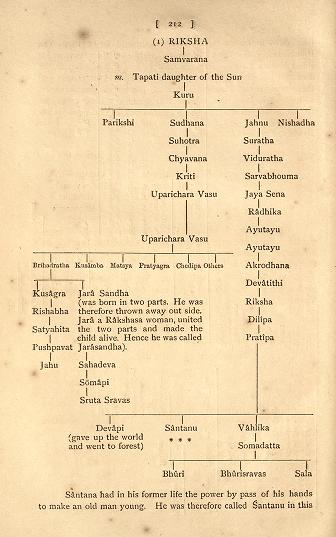
| JANMEJAY Janmejay was a Kuru king who reigned during the Middle Vedic period (12th-9th centuries BCE). Along with his father and predecessor Parikshit, he played a decisive role in the consolidation of the Kuru state, the arrangement of Vedic hymns into collections, and the development of the orthodox srauta ritual, transforming the Kuru realm into the dominant political and cultural center of northern India. He also appears as a figure in later legends and traditions, the Mahabharata and the Purans.
Ancestry of Anu-Janmejay :
Ancestry of Anu as per Bhagavat Puran Yayati → Anu → Sabhanar→ Kalanar → Janmejay → Maha Shal → Mahamans → (1.Ushinar + 2.Titiksh)
1.
Ushinara → Nriga + Krimi + Nava + Suvrata + Shivi
History
:
Inscriptional evidence mentions Dahisthal on the bank of Saraswati river where Kshemaraja Chalukya of Anhilvad did penance.
From the above discussion it is clear that the places mentioned is somewhere in the Haryana area. Now there is an important town near Panipat which is called Asandh even today and the area of Dahiya clan is not far from this place. It is therefore clear that the ancient Asandi or Asandivat is the present Asand town and Dahisthal is the country of the Dahiya clan. Kinsariya inscriptions of Chachha Dahiya of 1056-57 SV. are reported in El, Vol. XII, pp. 56-57. He is mentioned as "Kulam Dahiyakam Jatam" and the inscriptions gives at least four generations of that prince. Another inscription of Chandravati Sitaleshvara Mahadeva temple mentions a Rauta Bhivasiha Dahiya and his son Rauta Uda Dahiya (Sl. No. 1856 of Inscriptions of North India).
In
Vedic Literature :
Historicity
:
Only one Janmejay is mentioned in Vedic literature; however, post-Vedic literature (Mahabharat and Purans) seems to indicate the existence of two kings by this name, one who lived before the Kurukshetra War was an ancestor to the Pandavs, and one who lived later and was a descendant. Historian H. C. Raychaudhuri believes that the second Janmejay's description better corresponds to the Vedic king, whereas the information available about first is scanty and inconsistent, but Raychaudhuri questions whether there were actually two distinct kings. He suggests that there "is an intrusion into the genealogical texts" of the late, post-Vedic tradition, which also has two of Janmejay's father Parikshit, possibly "invented by genealogists to account for anachronisms" in the later parts of the Mahabharat, as "a bardic duplication of the same original individual regarding whose exact place in the Kuru genealogy no unanimous tradition had survived."
Four copper-plate grant inscriptions purportedly issued during Janmejay's reign were discovered in the 20th century, but were proved to be fake by historians.
In
Puranic Literature :
In
Mahabharat :
Emperor Janmejay was responsible for the retelling of the famous epic Mahabharat, a story of Janmejay's ancestors from the time of Bharat up to the great Kurukshetra war between his great-grandfathers the Pandavs and their paternal cousins the Kauravas. The Mahabharat states that it was recited to Janmejay at the sarp satra (snake sacrifice) by the sage Vaishampayan to whom it had been imparted by his perceptor Vedvyas,] after he asked Vaishampayan about his ancestors.
Sarpa
satra (snake sacrifice) :
Janmejay bore a deep grudge against the serpents for this act, and thus decided to wipe them out altogether. He attempted this by performing a great Sarp satra – a sacrifice that would destroy all living serpents. At that time, a learned sage named Astik, a boy in age, came and interfered. His mother Manasa was a Nag and his father a Brahmin. Janmejay had to listen to the words of the learned Astik and set the then-imprisoned Takshak free. He also stopped the massacre of the Nags and ended all enmity with them (1,56). From that time onward, the Nags and Kurus lived in peace. The mass sacrifice was started on the banks of the river Arind at Bardan, now Known as Parham, a corrupt form of Parikshitgarh. A masonry tank (reservoir) said to have been built by Emperor Janmejay to mark the site of the sacrificial pit, known as Parikshit kund, still exists in Mainpuri district. This is known as Gowdvana. Close to this village a very large and high khera containing the ruins of a fort and some stone sculptures has been found. It is said to date back to the time of Emperor Parikshit. A popular local legend is that as a consequence of the virtues of that sacrifice snakes are still harmless in this place and its neighborhood.
Succession
:
Source :
https://www.jatland.com/ |
